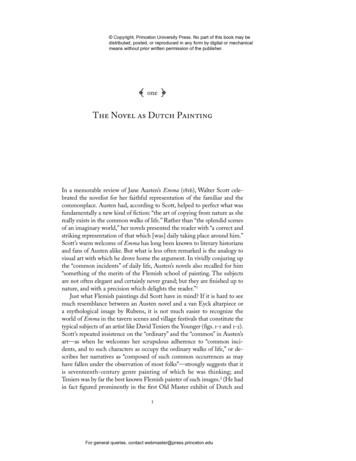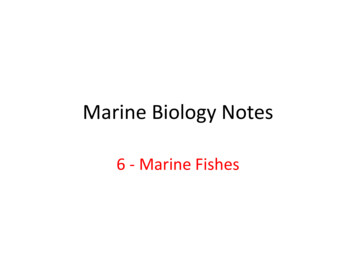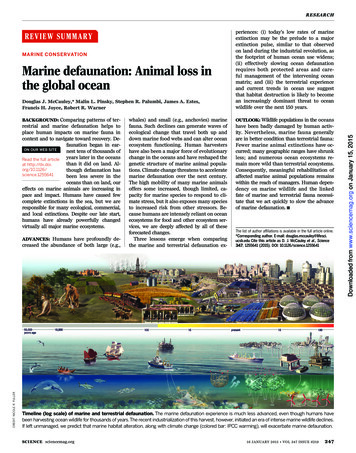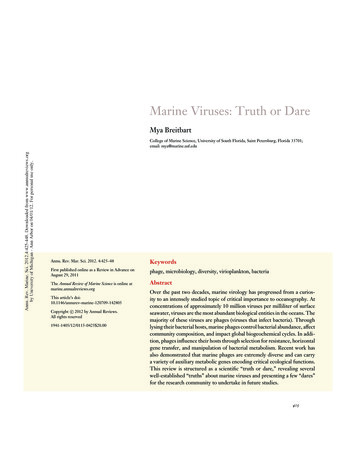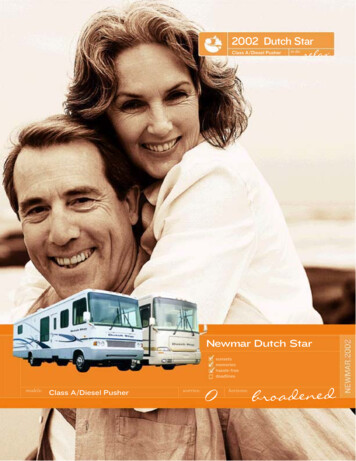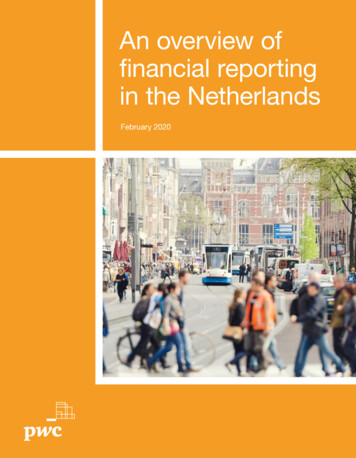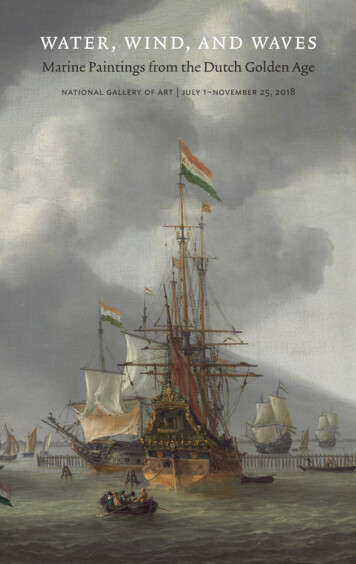
Transcription
water, wind, and wavesMarine Paintings from the Dutch Golden Agenational gallery of art July 1–November 25, 2018
Fig. 1Joan Blaeu, BelgicaFoederata (Amsterdam,1662), Reproducedwith the permission ofthe National Libraryof ScotlandFig. 2Aelbert Cuyp, The Maasat Dordrecht, c. 1650,National Gallery ofArt, Andrew W. MellonCollection(opposite)During the seventeenth century, The Dutchrose to greatnessfrom the riches of the sea. With their massive fleet of cargo shipsthey became leaders in international maritime trade and transport,while their mighty warships commanded the high seas. They established a successful herring industry with their vast array of fishingboats, and they navigated local estuaries, rivers, and canals withtheir yachts and barges. The water was also a great source of enjoyment. In the warm summer months dune-lined beaches offeredscenic vistas, while in the winter frozen canals provided a place forpeople of all ages to skate, play, and take pleasure in the outdoors.In this nation of sailors and skaters, it is no wonder that depictionsof life on the water became a favorite subject of artists and collectorsalike. Artists including Hendrick Vroom, Jan van Goyen, Willemvan de Velde the Younger, and even Rembrandt van Rijn portrayedthe water as an essential part of Dutch life and culture. This exhibition brings together some forty-five paintings, prints, drawings,rare books, and ship models to explore the multi faceted relationship the Dutch had with the water during the Golden Age of theseventeenth century.The Military Power of the Dutch at SeaWith more than six hundred miles of continuous coastline andestuaries, a series of major rivers, and countless canals and waterways, the Netherlands is defined by water (fig. 1 ). To judge fromthe volume of marine imagery, water has long defined its art, aswell. Majestic depictions of Dutch maritime power, such as AelbertCuyp’s The Maas at Dordrecht, have become synonymous with theGolden Age (fig. 2 ). In this large and impressive painting, Cuypdepicted a fleet of Dutch warships, yachts, and ferryboats carryingthirty thousand soldiers who had assembled as a show of force priorto the Treaty of Münster that ended the Dutch war of independence against Spain (1568 –1648).Despite the omnipresence of water, it became a subjectof Dutch artists only at the beginning of the seventeenth century,when Hendrick Vroom turned his attention to maritime scenes.Born in Haarlem, Vroom spent large parts of his career travelingfrom the Netherlands to Spain, Italy, Germany, and England.During that time he sailed on various transport vessels evenenduring a shipwreck off the coast of Portugal which gave himfirsthand knowledge of ships, ropes, rigging, and, above all, thesplendor and power of the sea. Drawing on these experiences in hispaintings, Vroom helped establish new categories of images, ranging from portraits of single ships to depictions of great convoys,and from fierce naval encounters to quiet harbor scenes.Vroom possessed a keen understanding of naval architecture aswell as a master ful ability to imbue his scenes with lifelike effects.His Fleet at Sea pictures the broadside of a twenty-four-gun Dutchwarship in a harbor bustling with fishing and cargo boats (fig. 3 ).The ship teems with sailors, some of whom climb the rigging.Vroom matched their dynamism with his rendering of the roiled
sea. Intense contrasts of iridescent greens and soft blues conveythe water’s changing depth, while delicate touches of white atthe waves’ crests suggest wind whipping across the surface. Thepictorial celebration of Dutch maritime prowess gained popularity,with paintings such as Vroom’s finding an eager clientele amongadmiralties and municipal organizations.Long after the Dutch achieved their freedom from Spain in1648, depictions of naval battles remained a popular artistic subject particularly after war broke out with England, another maritime rival, in the 1650s and 1660s. Willem van de Velde the Youngerwas well known for his chronicles of important naval encounterswith the English. Occasionally, he even produced monumentalcommemorative works years after these encounters had taken place,as in his Dutch Fleet Assembling Before the Four Days’ Battle of 11 –14 June1666, which he painted in 1670. In this dramatic scene, two famedships of the Amsterdam admiralty the Liefde (Love) at left andGouden Leeuwen (Golden Lions) at right set sail for a confrontationwith the English that would go down in Dutch annals as a gloriousnaval victory (fig. 4 ). Aboard the Liefde, a seventy- cannon man-ofwar, crewmen busily stow a half-raised anchor against the side ofthe hull while others scramble to unfurl the foresail; meanwhile,the Gouden Leeuwen has already embarked on its mission. Ominousclouds add to the atmosphere of excitement and anticipation onthe eve of this maritime battle that would bring great pride to theDutch nation.fig. 3Hendrick CornelisVroom, A Fleet atSea, c. 1614, PrivatecollectionFig. 4Willem van de Veldethe Younger, The DutchFleet Assembling Beforethe Four Days’ Battle of11 – 14 June 1666, 1670,On loan from MoveoArt Collection(opposite)The Mercantile Might of the Dutch in the WorldThe Dutch East India Company, founded in 1602, and West IndiaCompany, founded in 1621, connected the globe through a vastnetwork of trade routes that stretched from the Caribbean to theIndian Ocean, New Amsterdam (New York) to Asia. As they sailedthe seven seas, Dutch ships transported luxury goods exotic spicesand rare flower bulbs from the Far East, salt from Brazil as well asmore utilitarian items, such as lumber from the Baltic used for construction and shipbuilding. An ugly side of this global commercewas the Dutch involvement in the transatlantic slave trade, thoughslave ships were rarely depicted in their marine imagery. The globalscale of commerce created enormous wealth, in turn stimulatinga booming art market. Scenes of maritime trade were particularlyappealing to newly affluent investors, for whom they representedthe means of their economic success.One of the most active midcentury marine artists was ReinierNooms, also known as Zeeman (Seaman). Nooms was particularlyinspired by the bustling Amsterdam harbor, which he capturedin paintings and prints. Amsterdam Harbor Scene features a warshipat right alongside three merchant ships moored inside the harborfor maintenance and repair (fig. 5 ). Nooms’s careful depiction ofthe rigging on these vessels epitomizes his expert eye for nauticaldetails. Amsterdam’s harbor was the source of the city’s prosperity;then, as now, sightseers toured the port in transport boats, as forexample in the canopied barge carrying onlookers in the foreground of Nooms’s painting (see back cover).
In contrast to such activity in Amster dam’s harbor, Abrahamde Verwer concentrated on the hushed beauty of the water in hisView of Hoorn (fig. 6 ). Hoorn was a major port for trade to the Balticand the Indies and housed offices of both the East and West IndiaCompanies. Here De Verwer depicted the scene that greeted sailorsas they crossed the Zuiderzee (an inlet opening to the North Sea).Sailors aboard a large cargo ship grasp at lines as they raise goodsbrought by the smaller transport vessel moored alongside it. DeVerwer devoted much of his painting to the sky and water, rendering with great sensitivity the rose-colored band of clouds and delicate ripple of waves, the two realms divided by a small sliver of land.De Verwer’s remarkable draftsmanship is evident in the thin blackstrokes that articulate the many masts peaking up from the harborand the delicately rendered towers and steeples of the city’s profile.Transportation and Tranquility on Local WatersWhen Dutch merchant ships returned home from foreign shoresand fishing boats came in from the North Sea, barges carried theirgoods to local markets via an extensive system of coastal and inlandwaterways. These canals and rivers proved just as efficient for thetransportation of passengers. During the seventeenth century onecould go by barge from Amsterdam to Haarlem in an hour, withtrips leaving every hour. The journey from Haarlem to Leiden tookFig. 5Reinier Nooms, calledZeeman, AmsterdamHarbor Scene, c. 1658,National Gallery ofArt, The Lee and JulietFolger FundFig. 6Abraham de Verwer,View of Hoorn, c. 1650,National Gallery of Art,Fund given in honor ofDerald Ruttenberg’sGrandchildren(opposite)two hours, and that from Delft to The Hague one hour and fifteenminutes. Perhaps not surprisingly, ferryboats became a marinesubject favored by Dutch painters, particularly Jan van Goyen. HisView of Dordrecht from the Dordtse Kil includes a sailboat called a kaag atleft ferrying passengers who embark and disembark from smallerrowboats (fig. 7 ). This painting captures, in a subtle range of ochersand grays, the calm serenity of the day: thick layers of clouds coverthe sky, limpid sails hang from masts, and the water laps gentlyagainst the shore.For Simon de Vlieger, moments of tranquility in and aroundthe Dutch coast were not only beautiful, but also spiritual. InEstuary at Day’s End, two workers tar the hull of a ship resting on asandbar at low tide (fig. 8 ). Black smoke from the fire heating thetar billows up and white smoke erupts from a distant ship firing asalute, yet De Vlieger created an overall placid mood with a subtlerange of grays and blues. The crepuscular rays of sunlight beamingthrough the clouds are sometimes known as “God rays” or “fingersof God.” One can easily imagine how De Vlieger, who also paintedreligious subjects and made designs for stained-glass church windows, considered this atmospheric occurrence a visible confirmation of God’s blessing of the Dutch, who believed themselves to bea chosen people.The Beauty and Power of the SeaWhile the Dutch were grateful for the bounty provided by the sea,its power and unpredictability posed an ever-present risk. TheNetherlands (literally, low lands) is located largely below sea level.During the early seventeenth century, tidal deluge was a constantthreat, while arable, pastoral acreage was scarce. Between 1590
Fig. 7Jan van Goyen, Viewof Dordrecht fromthe Dordtse Kil, 1644,National Gallery of Art,Ailsa Mellon Bruce Fund(opposite)Fig. 8Simon de Vlieger,Estuary at Day’s End,c. 1640/1645, NationalGallery of Art, Patrons’Permanent Fund andThe Lee and JulietFolger Fund in memoryof Kathrine Dulin Folger(opposite)Fig. 9Ludolf Backhuysen,Ships in Distress offa Rocky Coast, 1667,National Gallery ofArt, Ailsa MellonBruce Fundand 1640, reclamation efforts added some two hundred thousandacres of land, over a third of which came as a result of windmillspumping water into a sophisticated network of dikes, canals, andlocks that helped control water levels throughout the land. TheDutch had a clear understanding of the overwhelming force anddestructive power of water, for when dikes broke, the land flooded,and when storms battered ships at sea, countless lives and precious cargo were put in jeopardy. These dangers cut across society, affecting sailors, merchants, fishermen, and passengers. Fewpaintings capture the threat posed by a storm as compellingly asLudolf Backhuysen’s Ships in Distress off a Rocky Coast (fig. 9 ). Dutchcargo ships buffeted by violent winds and roiling waves struggleto stay clear of the coast and avoid the fate of the doomed ship whosecargo, mast, and flag are seen floating in the water. Anxious sailorswork to bring their vessels under control as waves crash againstthem. The Dutch took pride in their ability to prevail againstsuch calamities through perseverance and faith. In Backhuysen’scomposition, this optimism in the face of peril is represented by thegolden light breaking through the clouds at left, signaling that thestorm is about to pass and that these ships will survive.Taming the water was a matter of survival, but mastering itschallenges could be a great source of satisfaction. Willem van deVelde the Younger’s Ships in a Stormy Sea captures the sense of exhilaration a sailor feels as he charges across choppy water on a windyday (fig. 10 ). Close-hauled to the wind, his boat triumphantlybreaks through the waves. A burst of sunlight illuminates the tautsail and silhouettes the skipper who, undeterred by the steel-grayclouds overhead, harnesses the energy of nature.The Pleasures of the WaterThe water, which was so essential to the formation of the DutchRepublic, was also a great source of enjoyment at all times of theyear the summer and winter pastimes associated with it providednumerous subjects for artists. Skating scenes were extremely popular in the Netherlands in the first half of the seventeenth century,which experienced some of the severest winters of the so-calledLittle Ice Age. During the winter months, people of all ages andsocial classes would take to the ice on hundreds of frozen canals
Fig. 10Willem van de Veldethe Younger, Ships in aStormy Sea, 1671 – 1672,Toledo Museum ofArt; Purchased withfunds from the LibbeyEndowment, Gift ofEdward DrummondLibbey(opposite)Fig. 11Hendrick Avercamp,Winter Games on theFrozen River Ijssel,c. 1626, NationalGallery of Art, WoodnerCollection, Gift ofAndrea WoodnerFig. 12Rembrandt van Rijn,The Bathers, 1651,National Gallery of Art,Rosenwald Collectionbisecting cities and connecting towns. The ice provided a sense offreedom that Hendrick Avercamp captured in his drawing WinterGames on the Frozen River Ijssel, with people skating, playing kolf (a crossbetween modern-day hockey and golf ), ice fishing, traveling inhorse-drawn sleighs, and socializing (fig. 11 ).In the summer months, the Dutch would gather on dunelined beaches to enjoy sea breezes or head to swimming holes dappled with shade on secluded river banks to cool off. In Rembrandtvan Rijn’s The Bathers, an intimate etching of summer recreation,men have come to an isolated spot to find respite from the heat(fig. 12 ). With remarkable liveliness yet economy of line, Rembrandtconveyed the dense foliage of this private location. A series of vertical and horizontal marks suggests the stillness of the water, whilethe figures’ languid postures evoke the lazy mood of a hot day.Shipbuilding and Model-MakingThe enthusiasm for marine subjects extended from two-dimensionalpaintings, prints, and drawings to three-dimensional ship models.The Dutch shipbuilding industry was unparalleled in Europe, bothin size and in expertise. During the seventeenth century, the EastIndia Company shipyard in Oostenburg was the largest in Europe,with 1,400 workers on-site. It included a warehouse for the goodsand items amassed by the East India fleet, storage for supplies, aforge, a slaughterhouse, a steam building for bending woodenplanks, and a pharmacy, not to mention sheds for constructingall the ships’ constituent parts. With these resources, the Dutchbuilt the light, fast, and reliable ships that propelled them to theforefront of global maritime trade and transport.Ship models, which were manufactured by the same handsthat produced large-scale ships and sometimes reproduced actual,existing ships, were valuable both as documents of Dutch navalarchitecture and as finely crafted objects for display. Models of amodest scale were commonly owned by private collectors, whilelarger models were typically commissioned for the boardrooms ofa large organization, such as one of the five admiralty boards of theDutch naval administration. (Located in the main ports of Rotterdam, Zeeland, Amsterdam, Hoorn, and Harlingen, the boards wereresponsible for equipping the Republic’s naval fleets and managingits import and export taxes.)
Fig. 13Anonymous Dutch 17thCentury, Dutch Statesyacht, c. 1690, KriegsteinCollectionFig. 14Anonymous Dutch17th Century, DutchStates yacht, PeabodyEssex Museum, Salem,Massachusetts, Gift ofMrs. Henry GoodwinVaughan(opposite)The late seventeenth-century model of a States yacht was likelycreated for an individual associated with the admiralty of Zeeland,the southernmost coastal province of the Netherlands (fig. 13 ). Theroundels on the model’s stern feature the Zeeland arms as well asa red castle that is the symbol of Aardenburg, perhaps suggestingthat the owner lived in that small coastal town. Yachts were light,swift vessels designed to carry out the various harbor duties ofregulating shipping, collecting revenue, and preventing piracy.A small hull, such as on this model, would have allowed the yachtto go through shallow waters, and a leeboard attached to its sideswould have helped stabilize its course a design that would havebeen particularly advantageous for a crew charged with chasing thesmugglers who plied shallow Dutch waters.A much larger model of a States yacht may have belonged toone of the admiralty boards or to the city magistrates, though itis no longer known which one (fig. 14 ). Objects of this scale werecertainly meant for public display perhaps in a city hall or boardroom. This model may have commemorated the vessel used by thetown magistrates to tour their harbor, or perhaps it replicated theprivate yacht of the admiral, who had to maneuver quickly throughthe fleet during naval battles. The elaborate decorations, includingthe figurehead and other intricate carvings, are common featuresof States yachts.The Dutch were enormously proud oftheir watery world,which they explored in paintings, prints, and drawings that are asbeautiful as they are varied. Whether quiet harbor vistas or stormyseascapes, wintry skating scenes or summery bathing studies, theseimages tell the story of the marine activities that drove the Dutcheconomy, the seafaring prowess that ensured Dutch independence,and the natural beauty that assured the Dutch people of God’spresence. Their exquisite ship models reflect the importance oftheir shipbuilding industry and celebrate the artistry and performance of the vessels that sailed for the Dutch Republic. In thisnation of seafarers, the popularity of marine imagery comes as nosurprise; the extraordinary range of marine images they produced,however, is remarkable. Collectively, these works speak to theall-encompassing importance of the water in the Dutch Golden Age.
Exhibition ChecklistHendrick AvercampDutch, 1585 – 1634A Scene on the Ice, c. 1625oil on panel39.2 77 cm (15 7/16 30 5/16 in.)National Gallery of Art, Washington,Ailsa Mellon Bruce Fund, 1967.3.1Hendrick AvercampDutch, 1585 – 1634Winter Games on the FrozenRiver Ijssel, c. 1626pen and black and gray ink withwatercolor, gouache, and graphiteon laid paper; laid down19.9 33.1 cm (7 13/16 13 1/16 in.)National Gallery of Art, Washington,Woodner Collection, Gift of AndreaWoodner, 2006.11.3 (fig. 11)Ludolf BackhuysenDutch, 1630 – 1708Ships in Distress off a Rocky Coast, 1667oil on canvas114.3 167.3 cm (45 65 7/8 in.)National Gallery of Art, Washington,Ailsa Mellon Bruce Fund, 1985.29.1(fig. 9)Matthys BalenDutch, 1611 – 1691View of Dordrechtin Beschryvinge der stad Dordrecht, 1677engraving28.5 37.4 cm (11 1/4 14 3/4 in.)National Gallery of Art Library,Washington, David K. E. Bruce FundJan de BisschopDutch, 1628 – 1671David Vlugh, after 1667engraving and etching43.3 30.8 cm (17 1/16 12 1/8 in.)National Gallery of Art Library,Washington, Department of ImageCollections, Gift of Peter and EvelynKrausHans BolNetherlandish, 1534 – 1593Winter Landscape withSkaters, c. 1584/1586pen and brown ink and washon laid paper19.3 26.9 cm (7 5/8 10 9/16 in.)National Gallery of Art, Washington,Gift of Robert H. and Clarice Smith, inHonor of the 50th Anniversary of theNational Gallery of Art, 1991.15.1Herman PadtbruggeDutch, 1656 – 1686The Battle of the Downs, 1639in Lambert van den Bos, Leevenen daaden der doorluchtigstezee – helden, 1683engraving21 36.8 cm (8 1/4 14 1/2 in.)National Gallery of Art Library,Washington, David K. E. Bruce FundJoan BlaeuDutch, 1596 – 1673Map of Amsterdamin Novum ac magnum theatrum urbiumBelgicae regiae, 1649engraving58.4 88.9 cm (23 35 in.)National Gallery of Art Library,Washington, J. Paul Getty Fundin honor of Franklin MurphyAdam van BreenDutch, c. 1585 – 1640Skating on the Frozen Amstel River, 1611oil on panel44.3 66.5 cm (17 7/16 26 3/16 in.)National Gallery of Art, Washington,The Lee and Juliet Folger Fund, inhonor of Arthur K. Wheelock, Jr.,2010.20.1Aelbert CuypDutch, 1620 – 1691A Pier Overlooking Dordrecht, early 1640soil on panel44.5 75.5 cm (17 1/2 29 3/4 in.)National Gallery of Art, Washington,Gift of George M. and Linda H.Kaufman, 2012.73.1Aelbert CuypDutch, 1620 – 1691The Maas at Dordrecht, c. 1650oil on canvas114.9 170.2 cm (45 1/4 67 in.)National Gallery of Art, Washington,Andrew W. Mellon Collection, 1940.2.1(fig. 2)Jan van GoyenDutch, 1596 – 1656View of Dordrecht fromthe Dordtse Kil, 1644oil on panel64.7 95.9 cm (25 1/2 37 3/4 in.)National Gallery of Art, Washington,Ailsa Mellon Bruce Fund, 1978.11.1(fig. 7)Jan van GoyenDutch, 1596 – 1656Ice Scene near a WoodenObservation Tower, 1646oil on panel36.5 34.3 cm (14 3/8 13 1/2 in.)National Gallery of Art, Washington,The Lee and Juliet Folger Fund,2014.35.1Jan van GoyenDutch, 1596 – 1656View of Dordrecht from the North, c. 1651oil on canvas63.1 87.2 cm (24 13/16 34 5/16 in.)National Gallery of Art, Washington,Corcoran Collection (William A. ClarkCollection), 2014.136.34Bartholomeus van der HelstDutch, 1613 – 1670Admiral Egbert Meesz Kortenaer, c. 1665engraving57.3 42.9 cm (22 9/16 16 7/8 in.)National Gallery of Art Library,Washington, Department ofImage Collections, Gift of Peterand Evelyn KrausPieter van der HeydenFlemish, active c. 1551/1572Winter (after Hans Bol)engraving28.5 37.4 cm (11 1/4 14 3/4 in.)National Gallery of Art, Washington,Rosenwald Collection, 1980.45.185Ludolf de JonghDutch, 1616 – 1679Admiral Aert van Nes, late 1600sengraving42.8 34.1 cm (16 7/8 13 7/16 in.)National Gallery of Art Library,Washington, Department of ImageCollections, Gift of Peter and EvelynKrausAert van der NeerDutch, 1603/1604 – 1677Winter in Holland: Skating Scene, 1645oil on panel54.6 69.9 cm (21 1/2 27 1/2 in.)National Gallery of Art, Washington,Corcoran Collection (William A. ClarkCollection), 2014.136.37Reinier Nooms, called ZeemanDutch, 1623 or 1624 – 1664Amsterdam Harbor Scene, c. 1658oil on canvas61 81.8 cm (24 32 3/16 in.)National Gallery of Art, Washington,The Lee and Juliet Folger Fund, 2011.3.1(fig. 5)Reinier Nooms, called ZeemanDutch, 1623 or 1624 – 1664Various Ships and Views of Amsterdam:Part I, c. 1652 /1654complete set of twelve etchings withdrypoint on laid paper50 139.2 cm (18 1/2 54 in.)National Gallery of Art, Washington,Pepita Milmore Memorial Fund,2016.89.1 – 12Reinier Nooms, called ZeemanDutch, 1623 or 1624 – 1664Various Ships and Views of Amsterdam:Part III, c. 1652 /1654complete set of twelve etchings withdrypoint on laid paper50 139.2 cm (18 1/2 54 in.)National Gallery of Art, Washington,Pepita Milmore Memorial Fund,2016.89.25 – 36Rembrandt van RijnDutch, 1606 – 1669View of Amsterdam from theNorthwest, c. 1640etching11.8 15.8 cm (4 5/8 6 1/4 in.)National Gallery of Art, Washington,Rosenwald Collection, 1943.3.7107Rembrandt van RijnDutch, 1606 – 1669Six’s Bridge, 1645etching13.9 23.6 cm (5 1/2 9 5/16 in.)National Gallery of Art, Washington,Rosenwald Collection, 1943.3.7145Rembrandt van RijnDutch, 1606 – 1669View over the Amstel fromthe Rampart, c. 1646/1650pen and brown ink with brown wash8.9 18.5 cm (3 1/2 7 5/16 in.)National Gallery of Art, Washington,Rosenwald Collection, 1954.12.114Rembrandt van RijnDutch, 1606 – 1669Canal with a Large Boat and Bridge, 1650etching and drypoint8.8 11.2 cm (3 7/16 4 7/16 in.)National Gallery of Art, Washington,Rosenwald Collection, 1943.3.7226Rembrandt van RijnDutch, 1606 – 1669View of Houtewael near the SintAnthoniespoort (recto), c. 1650reed pen and brown ink with graybrown wash and touches of whiteon laid paper12.5 18.3 cm (4 15/16 7 3/16 in.)National Gallery of Art, Washington,Woodner Collection, 1993.51.6.aRembrandt van RijnDutch, 1606 – 1669The Bathers, 1651etching11.7 14.3 cm (4 5/8 5 5/8 in.)National Gallery of Art, Washington,Rosenwald Collection, 1943.3.7223(fig. 12)Salomon van RuysdaelDutch, 1600/1603 – 1670River Landscape with Ferry, 1649oil on canvas101.5 134.8 cm (39 15/16 53 1/16 in.)National Gallery of Art, Washington,Patrons’ Permanent Fund andThe Lee and Juliet Folger Fund. Thisacquisition was made possible throughthe generosity of the family of JacquesGoudstikker, in his memory, 2007.116.1Esaias van de VeldeDutch, 1587 – 1630Villagers Skating on a Frozen Pond, 1625black chalk with brown washon laid paper18.9 14.3 cm (7 7/16 5 5/8 in.)National Gallery of Art, Washington,Ailsa Mellon Bruce Fund, 1994.79.1Willem van de Velde the ElderDutch, 1611 – 1693Dutch Ships near the Coast, early 1650soil and ink on panel59.4 83.5 cm (23 3/8 32 7/8 in.)National Gallery of Art, Washington,Gift of Lloyd M. Rives, 1994.61.1Willem van de Velde the YoungerDutch, 1633 – 1707Ships in a Gale, 1660oil on panel72.4 108 cm (28 1/2 42 1/2 in.)National Gallery of Art, Washington,Patrons’ Permanent Fund, 2000.72.1Willem van de Velde the YoungerDutch, 1633 – 1707The Dutch Fleet Assembling Before theFour Days’ Battle of 11 – 14 June 1666, 1670oil on canvas133.3 202.5 cm (52 1/2 79 3/4 in.)On loan from Moveo Art Collection(fig. 4)Willem van de Velde the YoungerDutch, 1633 – 1707Ships in a Stormy Sea, 1671 – 1672oil on canvas132.2 191.9 cm (52 1/16 75 9/16 in.)Toledo Museum of Art; Purchased withfunds from the Libbey Endowment,Gift of Edward Drummond Libbey,1977.62 (fig. 10)Willem van de Velde the YoungerDutch, 1633 – 1707An English Ship Running ontoa Rocky Coast in a Gale, c. 1690oil on canvas62 77.5 cm (24 7/16 30 1/2 in.)Kaufman Americana FoundationGeorge M.* and Linda H. KaufmanWillem van de Velde the YoungerDutch, 1633 – 1707Before the Storm, c. 1700oil on canvas26 43.2 cm (10 1/4 17 in.)National Gallery of Art, Washington,Corcoran Collection (William A. ClarkCollection), 2016.22.7Cornelis VerbeeckDutch, 1590/1591 – 1637A Naval Encounter between Dutch andSpanish Warships, c. 1618/1620oil on panel48.8 140.7 cm (19 3/16 55 3/8 in.)National Gallery of Art, Washington,Gift of Dorothea V. Hammond,1995.21.1 – 2Abraham de VerwerDutch, 1585 – 1650View of Hoorn, c. 1650oil on panel51.1 94.6 cm (20 1/8 37 1/4 in.)National Gallery of Art, Washington,Fund given in honor of DeraldRuttenberg’s Grandchildren, 2008.32.1(fig. 6)Simon de VliegerDutch, 1600/1601 – 1653Estuary at Day’s End, c. 1640/1645oil on panel36.8 58.4 cm (14 1/2 23 in.)National Gallery of Art, Washington,Patrons’ Permanent Fund and The Leeand Juliet Folger Fund in memory ofKathrine Dulin Folger, 1997.101.1 (fig. 8)Hendrick Cornelis VroomDutch, 1566 – 1640A Fleet at Sea, c. 1614oil on canvas56.5 97.1 cm (22 1/4 38 1/4 in.)Private collection (fig. 3)Pieter van der WerffDutch, 1665 – 1722Portrait of a Boy with a MiniatureThree-Master, 1696oil on canvas48.3 39.2 cm (19 15 7/16 in.)The Leiden Collection, New YorkAnonymous Dutch 17th CenturyThe Dromedaris, c. 1652hardwood (?), linen, and hemp71.1 27.9 71.1 cm(28 11 28 in.)Alan KriegsteinAnonymous Dutch 17th CenturyDutch States yacht, c. 1690hardwood, linen, brass, iron, mica,and hemp97.8 101.6 cm (38 1/2 40 in.)Kriegstein CollectionAnonymous Dutch 17th CenturyDutch States yacht, 17th centurycordage, metal, oak wood, mahoganywood, cotton, linen177.8 167.6 66 cm(70 66 26 in.)On loan from the Peabody EssexMuseum, Salem, Massachusetts, Gift ofMrs. Henry Goodwin Vaughan, 1945Sir Anthony DeanEnglish, 1638 – 1721The Royal James, 1st Rate of 1671, 1671fruitwood, silk, brass, and mica157.48 142.24 63.5 cm(62 56 25 in.)Kriegstein CollectionAnonymous 18th CenturyD’Jonge Tjeerd (The Young Tjeerd), 1781wood, cordage, canvas91.4 105.4 26.7 cm(36 41 1/2 10 1/2 in.)On loan from the Peabody EssexMuseum, Salem, Massachusetts, Gift ofMrs. Henry Goodwin Vaughan, 1944
For lectures and other programs,visit nga.gov/calendar.html.ON THE tmlGENERAL INFORMATIONAdmission to the National Galleryof Art and all of its programs is freeof charge, unless otherwise as noted.Hours: Monday – Saturday, 10:00 a.m. –5:00 p.m.; Sunday 11:00 a.m. – 6:00 p.m.Gallery website: www.nga.gov. Forinformation about accessibility togalleries and public areas, assistivelistening devices, sign-languageinterpretation, and other services andprograms, inquire at the InformationDesks, consult the website, or call(202) 842-6691.The exhibition is organized by theNational Gallery of Art, Washington.The exhibition is generously supportedby the Hata Foundation.Additional support is provided byThe Exhibition Circle of the NationalGallery of Art.This brochure was written byAlexandra Libby, assistant curatorof northern baroque paintings in thedepartment of northern baroquepaintings, National Gallery of Art.It was produced by the departmentof exhibition programs and thepublishing office, National Galleryof Art.This brochure is made possible byMr. and Mrs. Albert J. Beveridge III.#WaterWindWavesCopyright 2018 Board of Trustees,National Gallery of Art, Washingtoncover: Reinier Nooms, calledZeeman, Amsterdam Harbor Scene(detail), c. 1658, National Gallery ofArt, The Lee and Juliet Folger Fund
bition brings together some forty-five paintings, prints, drawings, rare books, and ship models to explore the multifaceted relation-ship the Dutch had with the water during the Golden Age of the seventeenth century. The Military Power of the Dutch at Sea With more than six hundred miles of continuous coastline and

